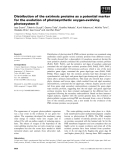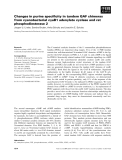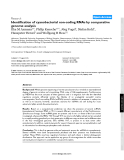
Cyanobacterial
-
Develop the process of producing crude extracts, fractions and pure chemical compounds isolated from E. fortunei; tudy of inhibitory effect of the crude ethanol extracts from E. fortunei on the growth of M.aeruginosa and evaluating their ecological safety to non-target aquatic organisms.
 28p
28p  larachdumlanat129
larachdumlanat129
 20-01-2021
20-01-2021
 33
33
 3
3
 Download
Download
-
The objectives of the thesis: Research, fabricate and determine the characteristic of three nanomaterials (silver, copper and iron) and evaluate the ability to inhibit the cyanobacteria of nanomaterials in fresh water bodies.
 27p
27p  xacxuoc4321
xacxuoc4321
 09-07-2019
09-07-2019
 30
30
 5
5
 Download
Download
-
Two ORFs, cphA and cphB, encoding proteins CphA and CphB with strong similarities to plant phytochromes and to the cyanobacterial phytochrome Cph1 of Synechocystis sp. PCC 6803 have been identified in the filamentous cyanobacterium Calothrix sp. PCC7601. While CphA carries a cysteine within a highly conserved amino-acid sequence motif, to which the chromophore phytochromobilin is covalently bound in plant phytochromes, in CphB this position is changed into a leucine.
 10p
10p  system191
system191
 01-06-2013
01-06-2013
 39
39
 4
4
 Download
Download
-
Distribution of photosystem II (PSII) extrinsic proteins was examined using antibodies raised against various extrinsic proteins from different sources. The results showed that a glaucophyte (Cyanophora paradoxa) having the most primitive plastids contained the cyanobacterial-type extrinsic proteins (PsbO, PsbV, PsbU), and the primitive red algae (Cyanidium caldarium) contained the red algal-type extrinsic proteins (PsO, PsbQ¢, PsbV, PsbU), whereas a prasinophyte (Pyraminonas parkeae), which is one of the most primitive green algae, contained the green algal-type ones (PsbO, PsbP, PsbQ)....
 11p
11p  fptmusic
fptmusic
 12-04-2013
12-04-2013
 41
41
 1
1
 Download
Download
-
Higher plant chloroplasts possess at least four different pathways for pro-tein translocation across and protein integration into the thylakoid mem-branes. It is of interest with respect to plastid evolution, which pathways have been retained as a relic from the cyanobacterial ancestor (‘conserva-tive sorting’), which ones have been kept but modified, and which ones were developed at the organelle stage, i.e. are eukaryotic achievements as (largely) the Toc and Tic translocons for envelope import of cytosolic pre-cursor proteins. ...
 12p
12p  awards
awards
 05-04-2013
05-04-2013
 36
36
 4
4
 Download
Download
-
A highly purified cytochromeb6f complex from the cyanobacterium Syn-echocystissp. PCC 6803 selectively binds one chlorophyll a and one caro-tenoid in analogy to the recent published structure from two other b6 f complexes. The unknown function of these pigments was elucidated by spectroscopy and site-directed mutagenesis. Low-temperature redox differ-ence spectroscopy showed red shifts in the chlorophyll and carotenoid spec-tra upon reduction of cytochrome b6, which indicates coupling of these pigments with the heme groups and thereby with the electron transport....
 11p
11p  awards
awards
 05-04-2013
05-04-2013
 38
38
 3
3
 Download
Download
-
Photosystem II (PSII), an essential component of oxygenic photosynthesis, is a membrane-bound pigment protein complex found in green plants and cyanobacteria. Whereas the molecular structure of cyanobacterial PSII has been resolved with at least medium resolution [Zouni, A., Witt, H.-T., Kern, J., Fromme, P., Krauss, N., Saenger, W. & Orth, P. (2001)Nature (London)409, 739–743; Kamiya, N. &Shen, J.R. (2003)Proc. Natl Acad. Sci. USA100, 98–103], the structure of higher plant PSII is only known at low resolution. ...
 5p
5p  dell39
dell39
 03-04-2013
03-04-2013
 44
44
 5
5
 Download
Download
-
The C-terminal catalytic domains of the 11 mammalian phosphodiesterase families (PDEs) are important drug targets. Five of the 11 PDE families contain less well-characterized N-terminal GAF domains. cGMP is the lig-and for the GAF domains in PDEs 2, 5, 6 and 11, and cAMP is the ligand for PDE10.
 10p
10p  galaxyss3
galaxyss3
 21-03-2013
21-03-2013
 32
32
 3
3
 Download
Download
-
The cyanobacterial plasma membrane is an essential cell barrier with func-tions such as the control of taxis, nutrient uptake and secretion. These functions are carried out by integral membrane proteins, which are difficult to identify using standard proteomic methods.
 14p
14p  galaxyss3
galaxyss3
 21-03-2013
21-03-2013
 37
37
 3
3
 Download
Download
-
Bacteriophytochromes constitute a light-sensing subgroup of sensory kin-ases with a chromophore-binding motif in the N-terminal half and a C-ter-minally located histidine kinase activity. The cyanobacteriumFremyella diplosiphon(also designated Calothrixsp.) expresses two sequentially very similar bacteriophytochromes, cyanobacterial phytochrome A (CphA) and cyanobacterial phytochrome B (CphB).
 11p
11p  galaxyss3
galaxyss3
 19-03-2013
19-03-2013
 30
30
 4
4
 Download
Download
-
The tandem GAF domain of human phosphodiesterase 11A4 (hPDE11A4) requires 72lmcGMP for half-maximal effective concentration (EC50)ofa cyanobacterial adenylyl cyclase used as a reporter enzyme. Here we exam-ine whether modifications in the N-terminus of PDE11A4 affect cGMP sig-nalling.
 8p
8p  media19
media19
 06-03-2013
06-03-2013
 33
33
 2
2
 Download
Download
-
It is widely accepted that chloroplasts derived from an endosymbiotic event in which an early eukaryotic cell engulfed an ancient cyanobacterial pro-karyote. During subsequent evolution, this new organelle lost its autonomy by transferring most of its genetic information to the host cell nucleus and therefore became dependent on protein import from the cytoplasm.
 11p
11p  vinaphone15
vinaphone15
 27-02-2013
27-02-2013
 39
39
 2
2
 Download
Download
-
The structure of the reduced form of cytochromec6 from the mesophilic cyanobacteriumSynechococcussp. PCC 7002 has been determined at 1.2 A ˚ and refined to an R-factor of 0.107. This protein is unique among all known cytochromesc6, owing to the presence of an unusual seven-residue insertion, KDGSKSL(44–50), which differs from the insertion found in the recently discovered plant cytochromesc6A .
 11p
11p  vinaphone15
vinaphone15
 25-02-2013
25-02-2013
 38
38
 1
1
 Download
Download
-
This minireview covers the research carried out in recent years into differ-ent aspects of the function of the flavoproteins involved in cyanobacterial photosynthetic electron transfer from photosystem I to NADP + , flavodox-in and ferredoxin–NADP + reductase. Interactions that stabilize protein– flavin complexes and tailor the midpoint potentials in these proteins, as well as many details of the binding and electron transfer to protein and ligand partners, have been revealed.
 17p
17p  vinaphone15
vinaphone15
 25-02-2013
25-02-2013
 36
36
 3
3
 Download
Download
-
Cyanobacterial NAD(P) + -reducing reversible hydrogenases comprise five subunits. Four of them (HoxF, HoxU, HoxY, and HoxH) are also found in the well-described related enzyme from Ralstonia eutropha.
 9p
9p  cosis54
cosis54
 09-12-2012
09-12-2012
 30
30
 1
1
 Download
Download
-
Tuyển tập các báo cáo nghiên cứu về y học được đăng trên tạp chí y học Wertheim cung cấp cho các bạn kiến thức về ngành y đề tài: Identification of cyanobacterial non-coding RNAs by comparative genome analysis...
 16p
16p  thulanh19
thulanh19
 09-11-2011
09-11-2011
 30
30
 1
1
 Download
Download
CHỦ ĐỀ BẠN MUỐN TÌM





























